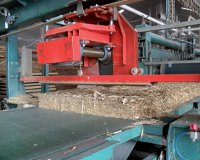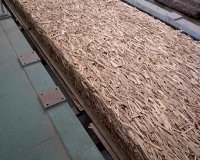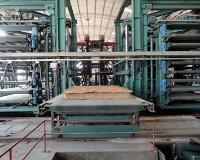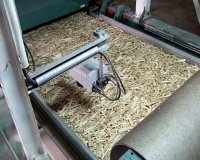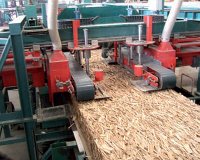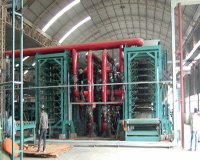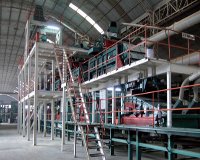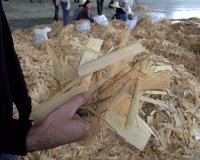Aiming for domination
18 June 2012Yunnan Yung Lifa Forest Co Ltd was established with a very specific goal in mind. That goal involved utilising bamboo in a completely new way, requiring some revolutionary technology. Mike Botting visited the company’s pilot plant in Mangshi, Dehong Prefecture, Yunnan province
Our story begins with a Kowloon, Hong Kong-based company called Panda Capital.
Owned 100% by Taiwanese and Swiss investors, Panda Capital is an investment company whose president is Taiwanese Ms Arfen Hsu and whose managing partner is a Swiss man, Andreas Schwyn.
Both people came from an unusual (to the panel industry anyway) but very successful business, making toothpaste tubes - a highly specialised product, laminated from aluminium and plastic and printed.
Having achieved virtual market domination in this product, they sold the business.
"We were then looking for niche markets with interesting volumes and where the supply chain needed a new solution," said Mr Schwyn. "For two years we toured China and met very many local governments and then we saw an opportunity in dry container flooring for maritime shipping.
"We found that three or four companies controlled 70 to 80% of that industry and realised that, with the right product, we could quickly occupy a large part of the market."
The standard material used for such container floors was, and had been for many years, tropical hardwood plywood, said Mr Schwyn.
"This material has a lot of issues: supply from Malaysia and Indonesia and other sources has become increasingly constrained by environmental issues; and board quality has become very poor.
"Today, 97% of the container floor market does not comply with shippers' specifications and good tropical hardwood plywood supplies aren't going to come back," asserted the managing partner.
The alternatives are limited due to the required tight specifications, he explained. Softwood plywood cannot meet the strength requirements and the eucalyptus and poplar commonly grown in China would also not suffice.
"As a result [of the poor quality plywood], container flooring maintenance costs have soared, claims have soared, and 50% of containers need repair after every use," said Mr Schwyn.
With conventional wood based boards discarded as unsuitable, other avenues had to be pursued and there is one resource which China has in abundance and which is little exploited, as he pointed out.
"China has 20% of the world's bamboo resource, there is no process for the mass production of bamboo products in this country, there is no standardisation and it is very labour-intensive."
Mr Schwyn acknowledged that there is also a large bamboo resource in the eastern coastal districts of China, but here there is a lot of demand for flooring products and craft goods.
In Yunnan, availability has no such constraints - and the potential for container flooring on the world market is massive.
"One order for container flooring is about 10,000TEU, or 3,750m3/month and the biggest producer of bamboo panel, which is woven, can produce only 1,500m3/month. One container production line, of which some container factories have up to three, needs 37,500m3/year of standardised flooring product," said Mr Schwyn.
Having found a potential resource, Yunnan Yung Lifa Forest Co Ltd, a wholly-owned subsidiary of Panda Capital set up to pursue the container flooring market, looked at ways in which that resource could be used to achieve its goal. The company was located in Mangshi, Yunnan province in 2005.
To keep a firm foothold in the market, and to allow its R&D to proceed, it should be mentioned that Yung Lifa had also set up its own production line for tropical hardwood plywood on the Mangshi site in 2005, signing a five-year contract to supply container flooring. This involved five peeling lines, layup, three drying lines and 10 eight-daylight hot presses.
Replacing tropical hardwood plywood with plywood made from bamboo was not the answer - it is too labour-intensive and the required capacity is also an issue.
"So we looked at the OSB process, but bamboo is a 'pipe' and very hard and dense. How could we produce strands? It was obviously going to be very different to wood as a raw material. How could we source and strand bamboo in serious volumes?" asked Mr Schwyn, rhetorically.
In 2008, Yung Lifa installed a semi-manual/semi-automatic laboratory line to produce 100m3 of bamboo OSB a month and conducted field tests of the product with a container manufacturer.
The results, said Mr Schwyn, were very positive and four years later nothing untoward had happened to the floor. He said his company had since supplied 5,000 container floors in bamboo OSB.
In 2009, having proved that bamboo OSB could work, the company set up a second research & development (R&D) line, focused on achieving a capacity of 4,000m3/month.
"We wanted to see if a continuous, automated, process to the required quality was possible," said the managing partner. "How big a capacity could we manage with the available supply and the large number of plantation owners we would have to deal with?"
The second pilot line was completed at the end of 2009, but it had a lot of problems and proved unusable.
Both R&D lines for OSB were supplied by a local machinery company, Kunming Engineering, and it was clear that Yung Lifa needed a new technology partner in this venture, with a new approach to the whole stranding process.
In January 2010, it partnered with Yumulai Automation Shanghai Co Ltd, owned and run by German engineers Bernd Henrich and Karakolidis Konstantinos.
"Yumulai completely redesigned our line and threw out 90% of the old one. We produced our first board in September 2011 and started the line properly in February 2012," said Mr Schwyn.
At the time of my visit in March, Yumulai was still working on some aspects of the stranding process, according to Mr Henrich.
"I am now working on a complete line to remove the 'skin' from the bamboo and on material preparation," he said. "Currently the stranding process is too labour-intensive.
"We have completed a small test strander and proved our concept and we now need to industrialise/scale-up that process."
The strander was not the only part of the line to receive attention from Yumulai, since bamboo strands present other challenges, too. Thus the internals of the dryers from Kunming Engineering were modified and a twin-screw feeder added, while the dosing and nipple systems on the glue blenders were also modified. The glue used is MDI with a paper release agent being employed up to now, but that was to be replaced shortly after my visit with a liquid release agent from Würtz.
Completely new forming heads were also designed and made by Mr Henrich's company and the resultant orientation of the strands at right angles in successive layers (it is a 'fiveply' board) was really impressive - not requiring the imagination that some claimed wood strand orientation does in conventional wood OSB. To this end, the forming bin feed has special flaps, again produced by Yumulai.
Before pre-pressing and then pressing in one of the eight-daylight presses originally installed for plywood production, the mat is 280mm thick.
The mat edge-trim system was again supplied by Yumulai, having to deal with this very thick, loose mat.
While optimisation of the line is going on, the company is still selling the production as container flooring.
The tight specification for the container flooring market includes having no voids in the surface of the panels, so Yung Lifa currently fills the surface with a textured phenol film.
"We believe that, eventually, the customers will accept the panel without the phenol film," said Mr Schwyn. "The companies which install the container floors coat the underside with a waterproof 'tar'."
Because of global market conditions, there has been over-capacity in the container business, and he estimates that it will take 12 months or so before demand really increases. However, demand is already increasing faster than expected, bamboo is the preferred material and bamboo plywood has no means of competing, said Mr Schwyn. This means that the smaller volumes currently produced by Yung Lifa will be sufficient for now.
That is just as well, because Mr Schwyn estimated in March that he needed six to nine months to gain experience with the line and get agreement with the customers concerning the finish.
"But, when the market recovers and the tropical hardwood flooring stock is all gone, people will be crying out for floors," said Mr Schwyn confidently.
Yung Lifa is convinced it has the product to meet all the very specific and tight specifications of the container floor market now that it has the Yumulai technology and has been able to conduct proper tests on the panels.
The bamboo OSB container flooring panels are 28mm thick and have a density of 850kg/m3 (tropical hardwood plywood is 1,000kg/m3). However, Yung Lifa is not exclusively focused on that market, but also sees potential for thinner panels (12-15mm) in concrete forming or export packing - competing with conventional wood based OSB and with domestic plywood.
When you have a good idea it is important to protect your rights to it and Yung Lifa holds around 20 Chinese patents for its OSB process and for bamboo OSB container flooring panels.
The current site is not large enough to accommodate a full-scale production line and is anyway scheduled for redevelopment for residential use.
However, Yung Lifa has already purchased a 23ha site 20 minutes' drive away and will build a complete new factory there.
Ms Hsu and Mr Schwyn have an almost missionary zeal to achieve their goal of domination in the container flooring market.
They seem confident that their enthusiasm and market research, combined with the engineering expertise of Yumulai, will enable their target to be achieved.
